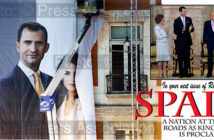Spain at the Crossroads
Of Europe’s twelve remaining monarchies the Spanish has had the most tumultuous recent history and its future is still not fully secured. Following the abrupt abdication of King Juan Carlos in favour of his forty-six year-old son, the proclamation of King Felipe VI opens a new and unpredictable chapter in the country’s history.
The history of the Spanish Bourbons is one of the great historical dramas. The dynasty has reigned from Madrid for over three centuries, with the interregnum of two brief republican periods and the dictatorship of General Francisco Franco. The dynasty’s rise to power came at the opening of the eighteenth century with the death of the mentally challenged Habsburg, Charles II. Charles was also without issue and had named his nephew, Philip of Anjou, the Bourbon grandson of King Louis XIV of France, as his heir.
This was anathema to the Habsburgs and to the other European powers, so provocative a move in fact that it caused a European conflict – the Spanish War of Succession between Bourbon ruled Spain and France opposed by an alliance of The Holy Roman Empire, Great Britain, The Dutch Republic, Portugal and The Duchy of Savoy, aiming to restore the Habsburgs to the throne. War dragged on until the Treaty of Utrecht was signed in 1713. Philip of Anjou was recognised as King of Spain (Felipe V) but renounced for himself and his descendants any claim to the French throne – the quid pro quo designed to prevent France from dominating the continent through dynastic union.

(Above) King Felipe VI and Queen Letizia wave to the crowd assembled outside Zarzuela Palace. (Top) A kiss to remember as King Felipe and Queen Letizia give the day one of its most memorable images. Alongside Felipe and Letizia are their daughters Leonor, Princess of Asturias, and (right) Princess Sofia. Photographs © Press Association.
Felipe VI’s coronation three centuries later comes in a very different time, when the accession of a new monarch could hardly lead to continental war. But it is a transitional period for Europe and not least for Spain itself, beset by economic woes and struggling with secessionism in its autonomous regions. Ironically it is not the accession of King Felipe VI that could destabilise the current European settlement but the possibility of his failure. The portents are mixed but some way from doom and gloom and, unlike so often in Spain’s pronunciamento laden, past the latest transition was constitutional and well received by the public.
There had however been a drama playing out behind the abdication of King Juan Carlos. Speculation had been growing for some time that he might step aside for his son to give the monarchy a new lease of life, but the announcement itself was surprising and did not have the feeling of an entirely voluntary decision, rather a final bowing to pressure. The news was broken by Prime Minister Mariano Rajoy on 2 June. In a televised broadcast to the nation he said: “His Majesty King Juan Carlos has just informed me of his desire to renounce the throne and begin the process of succession.” Mr. Rajoy went on to praise King Juan Carlos as a “tireless defender” of Spain’s interests. The monarch’s abdication address followed later that morning. There was little of the old fire but Juan Carlos’ candour was still visible with the admission of errors: “These difficult years have allowed us to make a balance of our errors and limits as a society. They have also reawakened the conscience that we have known and know what to do and that we are a great nation. This has sparked an impulse to renew and to overcome, to correct errors and open the way to a better future.” (Extract from Royalty Magazine Vol. 23/07)





